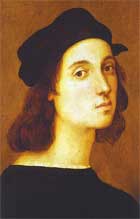Raphael - Biography
Raphael's biography is maybe the richest in accomplishments for such a short life.
Early years
Raphael Sanzio was born at Urbino in 1483. The fortunes of his family had been broken by war. The father, Giovanni Santi, was literate, and was also a painter at the court of Urbino. Of his mother, the boy Raphael knew little; and his father married again and died when Raphael was still quite young; but he may have given him early lessons and transmitted certain tendencies of feeling to this extremely sensitive mind.

Raphael Sanzio: Self Portrait
Uffizi, Florence
At around fifteen, Rapahel went to Perugia, where there were artists and schools; that is to say, apprenticeship in the workshop of painters. Pietro Vanucci, called Perugino, took him into his studio at the age of seventeen; perhaps he had some instruction at Urbino from Timoteo Viti, who was always his friend. And the one great gift of Raphael, a power of almost instant assimilation, must have enriched him from the earliest times by whatever he liked or tried to understand. All this early life is entangled with the work of Perugino, though it is made out that some of the very early pieces accredited to the more famous youth have something harking back to an earlier influence.
In those days, the work of the master was not only the example, but the model and the storehouse of the pupil. He borrowed this or that scheme and filled in with fragments of his own; or he imitated fragments to put into his own new scheme, as it happened with Raphael's Marriage of the Virgin (1504), heavily influenced by Perugino. And so every one borrowed from the other; it was not something wrong, it was a manner of admiration, and often a possible help when, as often happened, one artist called upon others to help him carry out his work. In such way Pinturicchio, also of Perugia, called upon Raphael for help in his work at Siena. It seems also that the youngster destined to be the more famous based some of his early work on the studies of Pinturicchio.
It was, therefore, with no small powers, original and acquired, that, after having worked at Siena, the young Raphael came up to Florence in 1504 with recommendation of the Duchess of Urbino to the Gonfaloniere.
Here, Raphael biography is intersecting (how else?) the great masters. There he found Leonardo da Vinci and Michelangelo designing the famous cartoons, now lost, which were among their greatest achievements, and which affected permanently the entire discipline of Italian and European art. Both these men he must have studied to some extent, as he also studied the earlier painters whose works were on the walls of the churches. Indeed, their memory lasted to that extent that Raphael, long after, merely transposed one of the great figures of Masaccio into his design of Paul preaching at Athens.
Raphael befriended the Monk Fra Bartolommeo, himself a serious student and painter, though only from obedience. Once upon a time he had given up art and entered the cloister, and had burned publicly the pagan works of his youth in the great bonfire which the puritans of Savonarola’s preaching built in horror of the excesses of art and luxury.
There was an interchange of knowledge between these two men; and in this companionship, under the influences of Florence, Raphael began to form the style by which we know him best. He has said himself that he paid attention to everything. It must also be said that he made all his own, that it was rather a renewal of himself than an accumulation of knowledge which defines this continuous increase in the wealth of his resources.